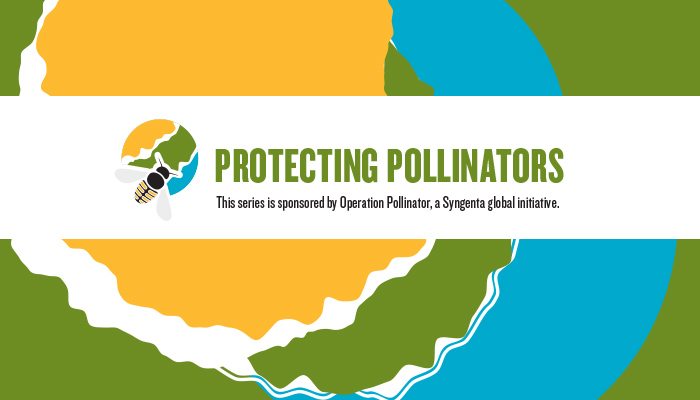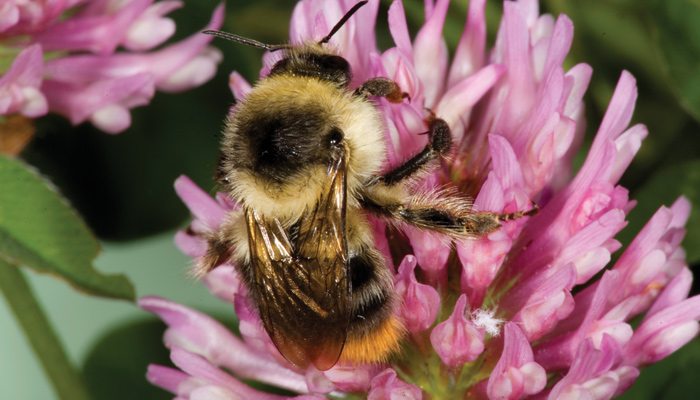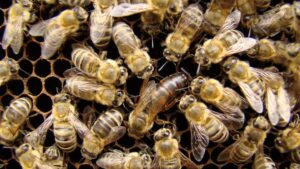Experts dispell misconceptions about honeybee health.
It’s no myth that bees are important. They contribute to one out of every three bites of food we eat, and are a vital part of a productive agricultural system, and every farmer has a respons-ibility to help preserve populations.
Plus, though honeybees aren’t needed for direct pollination of crops such as corn and soybeans, there are studies that show a benefit might still be present.
“Research is just coming out of Iowa State University that shows a potential yield increase for soybeans when honeybees are present, but beyond that, we need them for the health of the overall ecosystem,” says Shawn Conley, a University of Wisconsin, Madison, Extension soybean and wheat specialist.
There are many benefits to protecting pollinators; however, there is a swarm of misinformation. Here, experts from Syngenta provide clarity to debunk several myths about honeybee health.
Myth 1: Bee populations are declining rapidly.
In reality, the number of active colonies hasn’t dropped much in the past 20 years, according to Caydee Savinelli, pollinator and integrated pest management stewardship lead at Syngenta.
U.S. Department of Agriculture figures for both the 2014 and 2015 round to 2.7 million, but there was a slight decline in 2015, down 2.9 percent from the 2014 high of 2,740,000. However, the trend remains upward.
Some figures compare current bee populations to those 80 years ago.
“There are a couple of things to consider when you look at bee populations back in the 1940s,” Savinelli says. “We needed honey for sugar and the wax for war supplies. We have to look at the context.”
The number of colonies has actually risen in five of the past seven years. Plus, the number of managed hives that produce honey is up around 11 percent since 2006, when the initial findings of Colony Collapse Disorder (CCD) were recorded and colony levels were at their lowest.
On average, there are about 2.5 million bee colonies in the United States, Savinelli says. About 75 percent of those are transported to specific areas of the country for pollination purposes each year. Canadian pollinator populations are also on the rise, up about 17 percent between 2009 and 2014. Colony totals for the past two years are the highest since 1987, when a decline was associated with the arrival of Varroa mites.
It’s important to note that while pesticides have the potential to cause damage to individual bees, bees exist as part of a super-organism, the hive, which actually bounces back quite well from any unintended environmental exposure.
Myth 2: Seed treatments are harmful to bees.
Palle Pedersen, head of Syngenta Seedcare product marketing, has spent many years studying the most effective way farmers can apply pesticides to soybeans, and his research proves seed treatments simply aren’t a significant factor to pollinator populations.
“Seed treatments are an extremely targeted approach to pest management with none to minimal exposure to bees,” Pedersen says.
Seed treatments are applied to the seed, and are not sprayed all over fields, which results in less overspray issues.
“We track how these treatments affect the plant and one thing we monitor is the amount of pesticides that are present in pollen as well as nearby soil and other organic matter,” he says.
In fact, Pedersen reports that in Western Canada, farmers use seed treatments on all the canola fields, which is a very good source of pollen for bees, with no ill effects.
“Farmers are actually trucking in bees to these fields — just one example that shows seed treatments are not inherently harmful to bees,” he says.
Myth 3: Seed treatment and pesticide use are the biggest threats to bee health.
There are many factors that negatively affect bee health, including diseases, parasites, poor nutrition, climate change, queen failure and pesticides, both used in the hives and in agriculture. One of the biggest threats is the Varroa mite, a parasite that entered the United States in the late 1980s and feeds on bees and larvae.
“The Varroa mite is a huge threat. Not only is it a large parasite sucking the bee’s blood, the equivalent to the size of a dinner plate on a human’s back, but it also transmits diseases such as deformed wing virus which means the adult bees emerge with a deformity that affects their ability to fly,” Savinelli says.
The mite problem has to be managed and some beekeepers use miticides in the hive itself, which has its own potential levels of risk associated with it.
Another significant factor is the overall nutritional needs of a colony.
“Just like any livestock, bees need to have the right mix of nutrients throughout the year in order to stay healthy,” Savinelli says. “A varied forage environments is so important. Recent studies have shown a clear link between a varied diet and overall hive health. The more variety in their diet, the healthier the bees.”
It’s important to focus on sustainable solutions for all these issues, not target one cause and ignore the rest.
Myth 4: Neonicotinoids are not needed on the farm and have a negative impact on bees.
While there is no such thing as zero risk and some pesticides can be toxic to bees, neonicotinoids have come under especially intense media scrutiny when it comes to potential damage to bee populations. However, both Savinelli and Pedersen say those accusations aren’t fair, or well-founded. In truth, there is no direct link demonstrated between neonicotinoids, bee health or honeybee Colony Collapse Disorder.
“A lot of people think we shouldn’t use pesticides at all, and they’ve created a vendetta against neonics because they are the largest target,” Savinelli says. “All pesticides could potentially harm bees, but these are very widely used and the research proving they are unsafe at field relevant doses just isn’t there.”
Pedersen agrees. “Neonics are the largest group of insecticides used. They fit very well into an IPM program, and have proven to be safe to use,” he says.
In fact, neonicotinoids have been used since the early 1990s because they have been shown to be less harmful than the older chemicals they are meant to replace. And, as described above, bee populations haven’t seen a large-scale decrease in that time while neonicotinoid use continues to increase.
Myth 5: There’s nothing we can do to help bee populations.
Many factors affecting bee populations, such as diseases and mites, are out of the control of farmers, but that doesn’t mean there is no cause for action.
Instead, farmers can focus on providing increased nutritional opportunities for bees in their areas by planting forage plants. There are a number of programs in place, such as Operation Pollinator, a global Syngenta initiative that helps restore pollinators in agricultural, golf and other landscapes by creating essential habitats.
One of the most important things farmers can do is follow all label instructions for pesticide treatments carefully.
“Those labels are written to be very specific. We’re working on areas to improve stewardship for our customers by minimizing dust and ensuring products are used in the right way for maximum impact,” Pedersen says.
It’s also important to work closely with any beekeepers in the area.
“If bees are actively foraging, there can be more of a problem, so we need farmers to work with beekeepers to choose the best products and the right timing to minimize those risks,” Savinelli says.
It’s about communication and cooperation.
“The agricultural industry is a big community, a family,” Conley says. “We need to communicate with each other to know when those bees are out working. It’s the only way we can have a net positive for everyone involved.”
Even though bee populations aren’t in a sharp decline like many believe, there is still important work to be done to ensure the sustainability of our future food system. Companies such as Syngenta are committed to promoting and protecting pollinator populations.
And, for the most part, Conley has also seen farmers willing to take the steps to move forward to improve bee health.
“Whether that means planting a little earlier to avoid native pollinators working, or investing in advances in seed treatment coatings with less dust off, we’re learning to coexist so we can move forward,” he says.















